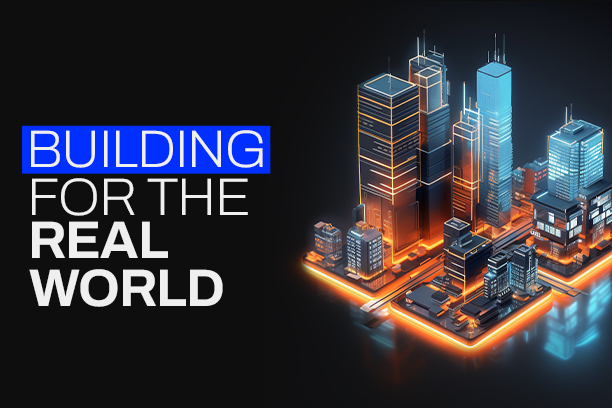Building for the Real World
In the early years of DeFi, composability was king. New protocols appeared almost daily, each promising higher yields, flashier tokenomics, and the next evolutionary leap in permissionless finance. Billions of dollars poured into protocols with little more than slick frontends and clever contracts. It was a time of experimentation—but also of abstraction.
Today, that era is fading. And if you ask blockchain architect Deniz Dalkilic, the co-founder of Lumia, the reason is simple:
“BlackRock CEOs and other Institutional players believe that tokenization is the way forward and that the current infrastructure that they have in place has to be upgraded to the next decade of financial systems that’s coming on chain.”
As someone who’s spent over a decade in the engine room of Web3 development, Deniz believes the next great wave of blockchain innovation won’t be driven by speculation, but by infrastructure—specifically, the infrastructure capable of bringing real-world finance on-chain.
DeFi Was the Sandbox, RWAs Are the Capital Playground
DeFi served its purpose. It exposed what was possible when financial services were rebuilt from the ground up, without intermediaries. But much of it was built on a circular logic of TVL chasing TVL, token rewards funding yield, and users rotating between protocols not for utility—but for arbitrage.
Deniz sees RWAs—real-world asset tokenization—as a fundamental reset.
“In DeFi, you’re making the most. If you enter last, you are the yield. That’s kind of what the process is.”
The difference is more than conceptual. RWAs demand legal clarity, identity checks, and infrastructure that can interact with existing financial rails. That’s why Deniz and his team at Lumia are building systems that go beyond frontend gimmicks and focus on enterprise-grade compliance from the base layer.
“Lumia is different because we’re building very specific features that cater to both institutions, the compliance side of things and what retail users or users want in general,”
The Infrastructure Layer Is Where the Power Lies

DeFi builders often prioritized the visible layers: interfaces, gamified staking dashboards, and colorful token designs. But for Deniz, this misses the point. The future of tokenized finance isn’t about eye candy—it’s about infrastructure.
Lumia is designed as a permissioned blockchain for RWAs. It’s not another DeFi playground—it’s a foundation.
“We try to find opportunities where we can optimize and improve what’s already out there so that we can actually truly offer something that’s needed in the space as opposed to just sort of hype driven or narrative driven products,” Deniz said.
And the implications are vast. This means programmable identity, native KYC, integration with legal contracts, and a framework for building apps that banks, asset managers, and governments can actually use.
While other chains may boast TPS benchmarks or DeFi integrations, Deniz argues that the real benchmark should be:
“So what happens after tokenization? Everybody focuses on tokenization. It’s for the issuance of a token. Yeah. But…how do you integrate that into DeFi, how can I borrow against it, how can I trade it actively on chain, then you start standing out and you start creating an area of interest for different users,
Compliance Is Not a Bottleneck—It’s the Model
If DeFi’s north star was permissionlessness, RWA infrastructure has a different guiding principle: trust, anchored in transparency and legal validity.
“I think regulatory clearance, maybe stuff like the Stablecoin Act in the US will start onboarding more institutions as well. And once that happens, then we can start really seeing liquidity flow in and out,” Deniz emphasized.
For years, crypto treated regulation as an afterthought. But RWA adoption is impossible without it. That’s why Lumia doesn’t avoid compliance—it’s built around it. From the architecture level, the chain includes identity management, permissioned access controls, and a modular compliance stack designed to satisfy the most conservative institutions.
This shift in mindset—from evasion to integration—marks a maturing of the crypto industry. And according to Deniz, it’s the only viable path if blockchain is to absorb traditional capital markets rather than remain siloed from them.
Institutions Aren’t Playing Games—They’re Watching Closely
BlackRock is building tokenized funds. Franklin Templeton is already issuing them. These firms aren’t experimenting—they’re preparing. And they’re not going to enter through DeFi farms or DAO governance tokens. They need rails that resemble the systems they understand—only better.
Deniz’s team at Lumia is offering exactly that: developer-friendly infrastructure that bakes in legal clarity.
“We have the token issuance side, so we have our own process, we have our own application that could also do tokenization up to the standard that the regulators need, including KYB, proof of reserve, the tracking of the asset that the regulatories need.”
In this world, yield doesn’t come from ponzinomics. It comes from tokenizing real estate, bonds, invoices, and physical goods—and enabling them to be traded, fractionalized, and settled on-chain.
The Next Crypto Revolution Will Be Grounded
DeFi changed the way we think about financial experimentation. But RWA infrastructure will change the way the world interacts with financial systems—permanently.
Deniz Dalkilic isn’t chasing the next liquidity pool. He’s building a foundation—one that bridges crypto-native principles with real-world accountability. And if his thesis proves right, the next cycle won’t be about yield farming or NFT mania. It’ll be about tokenizing trillions in real assets.
As he put it:
“In terms of RWA, I think people assume it’s just one of those hype narratives that you see in crypto in general. You know, it’s going to last for five months, six months, and then it’s going to fade out. But as I mentioned earlier, it’s actually one of those narratives that truly has weight to it and traction to it.”





